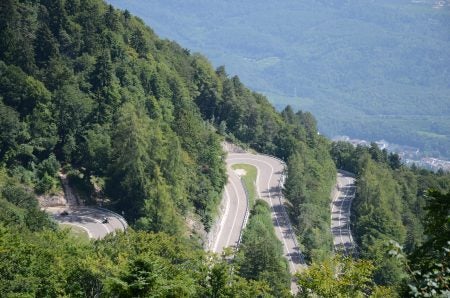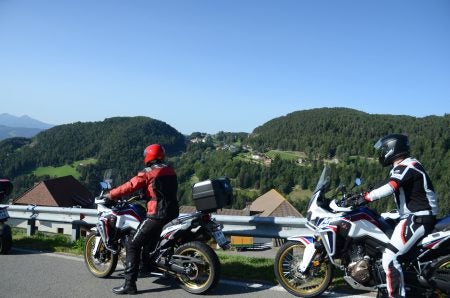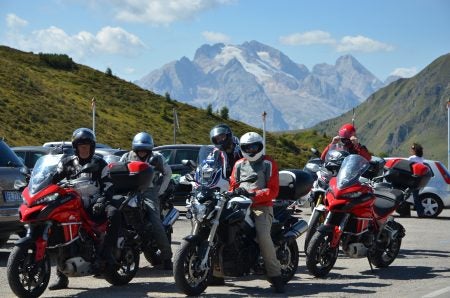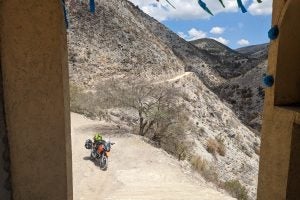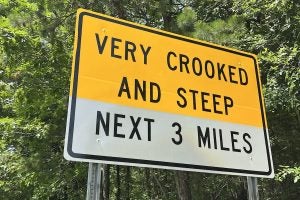This week, Steve shares a story of one of his own trips through Europe a while back—Ed.
On a bright summer morning in northeastern Italy, a small group of riders assembled at the Bolzano Safety Park in northeastern Italy to learn how to turn a motorcycle in strange ways, and to develop at least some skill at it. Our instructor: Christian Preining; the course: a small-group class in riding the high pass roads of European Alps – roads that challenge motorcycle riders in ways that can be both terrifying and giddy fun. The idea, to keep the fun and lose the terrifying, was promoted to Edelweiss Bike Travel by Preining years ago, and the Alps Riding Academy was born.
“You will look forward to hairpin turns,” Preining promised early in the session.
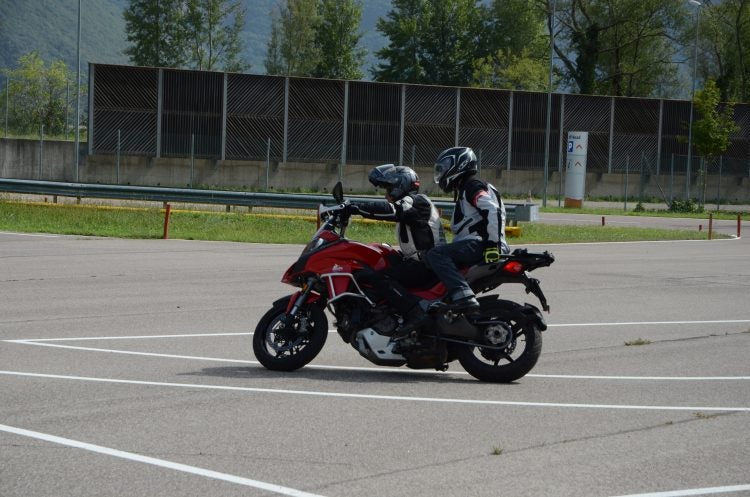
Preining counterbalances, leaning against the turn, while Thornton
leans with it on a demo ride.
In a back room of the Bemelmans Post hotel in the Dolomite mountains, Preining, who had been an Edelweiss tour guide for more than 20 years, talked to us about emergency braking, swerving, passing vehicles, counter-steering, seeing the road surface, and most importantly, tracing the right line through a corner, a line that will keep you apart from oncoming vehicles. Where that gets difficult is in the third dimension: these hairpin turns are so tight you can hear them squeak, but also so steep you want to keep your elbows tucked in. Keeping a motorcycle from stalling and toppling over at eight or nine miles an hour while turning 180 degrees and rising as if lifted by a crane is, in fact, easily accomplished. If you know what you’re doing. And for that, there was Preining, who proved to be enough.
Edelweiss advises riders to follow a “blue line” through a curve: going wide until the view ahead is clearly visible, then cutting to the inside, away from the oncoming lane. Preining said too many riders “turn in too early,” and can’t see trouble coming around the curve. Trouble like a bus, on a mountain pass road that seems to have been built by people on pogo sticks. By staying wide longer, you get to meet that bus on your own terms.
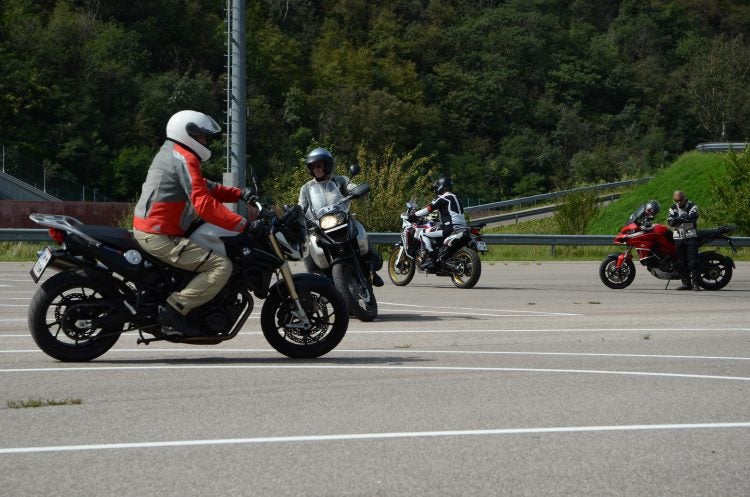
While his students practise their turns, Preining seems to be collecting his
sanity at right. Photo: Steve Thornton
Next, we headed down to the Safety Park, a wide, paved area with a mountain view and markings in the shape of lanes, circles, and other forms, all designed to improve a rider’s ability to control a motorcycle’s movement. We rode around a circle, and stopped with the bike pointed toward the outside, then around the other way and stopped toward the inside. Then, we rode between narrow, undulating lines, with a foot on the brake pedal and fingers on the clutch lever, balancing thrust and braking. Preining showed us how to use counterbalance at low speed, leaning away from the turn and pushing the motorcycle down, making it lean into the curve. This way, we could make adjustments to our line quickly and easily. If we were leaning into the turn as usual, we’d be committed to a single line that could become dangerous.
To make his point, Preining took us on as passengers, letting us lean into the turns while he sat up straight or leaned against them, squirting the bike through narrow, slow lanes with impressive, if jerky, precision.
We also practised braking, testing the ABS qualities that our Ducatis, BMWs, and Hondas had: on a Multistrada, I accelerated with gusto and then stepped hard on the rear brake, which didn’t upset the bike but almost didn’t stop it, either. Then, accelerate and bend the front brake lever to the bar: the bike sank on its fork and slowed hard enough to strain my forearms, with just a hint of a wiggle out back. It was a treat to feel a bike under me stop in that manner, and a useful lesson.
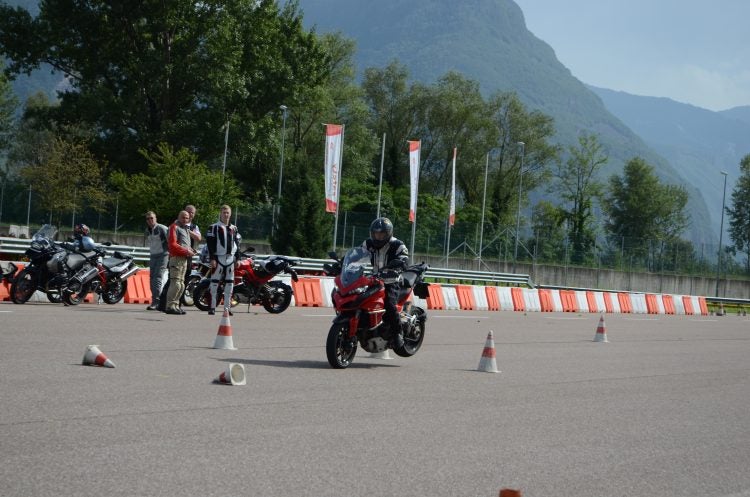
Preining demonstrates fearlessness in stopping, then will adjust
and ride through laid-down cones: a difficult feat for some. Photo: Steve Thornton
The last of the exercises was a swerving maneuver that I never did get right. Accelerate up to a marker, brake, then let go of the lever and swerve to miss a pair of laid-down cones. For me, braking hard after accelerating, then changing direction through a steering input, was too much, too soon, and I hit those cones every time. Later, Preining said that combining braking and swerving – that is, easing up but keeping the front brake on just a little while swerving – so it’s all one continuous action, works better, but the matter was still under study by Edelweiss. We finished the day with a slow race, and then Preining showed us how slow a motorcycle could really go: stopping, waiting, then moving just a bit, then stopping, and not quite moving backward, but almost.
For the rest of the week, we took to the fantastically entertaining roads through the rugged Dolomites, and as much as any of five or six Edelweiss tours I’ve been on, this section of the course, where we practised what we had just learned, was utterly captivating – and thrilling. Blazing through a set of twisties on the tail of Preining, fully alive and concentrating on speed, steering inputs, vision, and balance, watching his rear tire and trying to follow his line while the rest of the group disappeared from my mirrors, leaving just him and me, leaping past slow traffic on those marvellously powerful Multistradas, cutting through S-curves on roads in nearly perfect condition.

Preining consults a map with Olaf. Photo: Steve Thornton
We took turns following the leader, so each had a time riding behind and observing and, if intention is truth, copying his movements.
That area of Europe is filled with passes, the kind of road that skates up the side of a mountain, arcs over the top and falls back down the other side, precipitously in places, slowly in others, and often with not much room for mistakes. On a second tour a week or two later, somewhere else on these alpine roads, I followed a rider down the side of a mountain on a curl of pavement that had enough width in one spot for a car coming and a bike going – not two cars – and watched him and his passenger steal by the car, then went myself, and there is not time or usefulness in fear in that situation, only smooth forward motion.

The roads sometimes disappeared into rocky tunnels, sometimes
just went around a bend with a handy “turn here” sign and Christian Preining leading the
way. Photo: Steve Thornton
On these mountain pass roads, I was grateful for the Safety Park exercises, and I found that the Multistrada behaved well in right-hand, uphill hairpin turns, which I never did come to enjoy but which I learned to tolerate. A vehicle, even a bus, could be coming down through a hairpin while we were going up, that vehicle taking more than its fair share of road in the turn, necessitating quick slow-motion decisive adjustments on our part. These turns – the word “hairpin” (we call it a “bobby pin” in Canada) does describe their arc well – required us to slow down well before turning, and to pull out left as far as possible, then bend the bike in while counterbalancing like Preining had taught us, feathering the clutch, maybe toeing the brake pedal for stability, and modulating the throttle. Too many times I came closer to the center line than I wanted, and once or twice I crossed it, despite trying hard to do everything right. My greatest fear was that the Ducati would stall and fall down, but that big lump of a twin just chugged right along, no matter the steepness of the hill, and it didn’t come to pass.
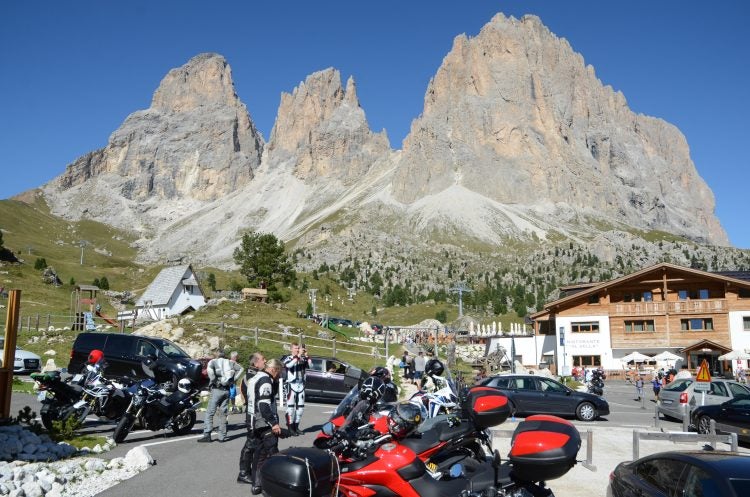
At rest stops there was often unforgettable
scenery. Photo: Steve Thornton
Speaking of passes: the Sella, the Manghen, the San Pelligrino, and maybe a dozen others: this was a training ride, meant to teach us how to do it, and we did learn, all of us, some more than others (I was one of the others). Preining stopped the group often for photos in brilliantly scenic places, and every day we stopped for coffee in some quaint, delicious little joint. As with all Edelweiss tours, the food and drink (espresso while riding, good wine and beer later on) was exquisite and fun, the rest stops frequent and comfy and entertaining, and everything possible was done to make the bikes fit the riders comfortably and effectively. After one incident, Preining was handed a Ducati with a bit of broken plastic; the next morning, a repair showed the tiniest circles of zip tie forming a repair that was simple and beautiful – Preining had drilled holes for the zip tie by hand-holding a drill bit, using his fingers! and getting it done with the care and precision of a surgeon, or a jeweler.
For most of that week, we stayed at the Bemelmans Post, and it was an experience of fulfilling joy. We took one day to ride to Lake Garda and hit some new roads, but otherwise, we were based in the lovely village of Collalbo and found roads heading away from there in all directions that would steal the heart of any motorcyclist, roads that snaked under and around the sides of those delicious Dolomites as if there was never any other intention than to make each of us happy – and then there were the heart-in-throat passes, each ridden with an air of accomplishment and congratulation. Fantastic.
- Photo: Steve Thornton
- Photo: Steve Thornton
- Photo: Steve Thornton
- Photo: Steve Thornton
It was my Ducati that Preining fixed, by the way. As we pulled into the garage at the Bemelmans Post on the evening after our Safety Park lessons, my Ducati stalled on some cobblestones and fell on its right side. My right leg was trapped under it, and I remember hearing people shouting, “Don’t move!” “Are you all right?” “What the hell?” A dozen hands lifted me and the bike, and we went into the hotel, then had dinner together, and nobody seemed to mind that I had dropped the Ducati, and it was as fine an evening as any I’ve ever had.



